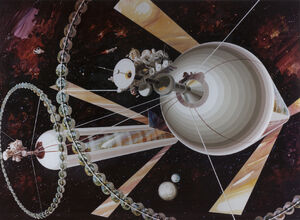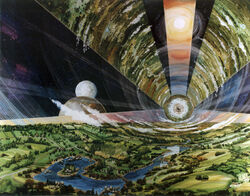XSuperGamer (talk | contribs) No edit summary |
(Adding categories) |
||
| Line 27: | Line 27: | ||
{{Wikipedia}} |
{{Wikipedia}} |
||
| + | [[Category:Types of Space Colonies]] |
||
Revision as of 19:58, 13 January 2014

A pair of O'Neill Cylinders
The O'Neill Cylinder, or Island Three, is a space colony design proposed by Gerard K. O'Neill.
O'Neill envisioned that the colony would be built using materials from the Moon. The materials would be launched into space using a mass driver.
The habitats themselves are cylinder-shaped, and are always built in pairs. Each one is five miles (8 km) in diameter, is 20 miles (32 km) long, and can house several million permanent residents. Each cylinder is divided into six equal-area strips that run down its side. Three strips are "land", and the other three are windows. The The two cylinders are counter-rotating and are connected at each end by a rod via a bearing system.
Artificial Gravity
The colonies rotate to provide artificial gravity on the inner surface. Because each cylinder has such a large radius, the colony rotates only 40 times per hour. At this low speed, no one would experience motion sickness. A person could detect spinward and antispinward directions by turning his or her head, and any dropped objects would appear to be deflected by a few centimeters. The central axis of the cylinder would be a zero-gravity region.
Atmosphere

An interior view of an O'Neill Cylinder
Each habitat would have half the air pressure of Earth's. 20% would be Oxygen, and 30% would be Nitrogen. This half-pressure atmosphere saves gas and reduces the strength and thickness required for the habitat walls. The cylinder shell and the air within provide shielding against cosmic rays.
Sunlight
Large mirrors are hinged to the back of each window. The unhinged edge points towards the sun so that the mirrors reflect sunlight into the habitat. The light reflected from the mirrors would be polarized, which could confuse bees. During the day, the Sun would appear to move as the mirrors move. The mirrors would open to simulate night as the window will view empty space. This also lets heat radiate into space. The windows would not be made of single panes, but instead would be made of many small sections to prevent catastrophic damage, and so the aluminum or steel window frames could take most of the stresses of the air pressure of the habitat.
If a meteorite broke one of the panes, some air would be lost but it would not be an emergency since the habitat is so large.
Attitude Control
The habitat and its mirrors must be aimed at the sun. In order to continuously turn the colony 360 degrees per orbit without using rockets that discard reaction mass, the pair of habitats must first be rolled by operating the cylinders as momentum wheels. If one habitat's rotation is slightly off, the two cylinders will rotate about each other. Once the plane formed by the two axes of rotation is perpendicular (in the roll axis) to the orbit, then the pair of cylinders can be yawed to aim at the sun by exerting a force between the two sunward bearings: away from each other will cause both cylinders to gyroscopically precess, and the system will yaw in one direction, towards each other will cause yaw in the other direction. The counter-rotating habitats have no net gyroscopic effect, and so this slight precession can continue for the habitat's orbit, keeping it aimed at the sun.
| This page uses Creative Commons Licensed content from Wikipedia (view authors). | 
|